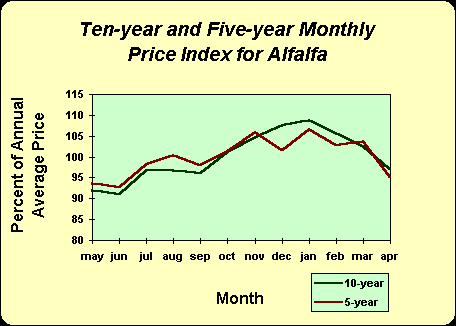
|
Oklahoma State University Stillwater, OK |
|
Oklahoma Alfalfa |
|

|
Oklahoma State University Stillwater, OK |
|
Oklahoma Alfalfa |
|
|
SEASONAL PRICE PATTERN FOR ALFALFA |
|||||||||||||||||||||||||||||||||||||||||||||||||||||||||||||||||||||||||||||||||||||||||||
|
Agricultural commodities have seasonal price patterns due to seasonal supplies, seasonal demands, or a combination of both. The seasonal price pattern for alfalfa hay reflects some of both. Table 1 contains seasonal price indexes for alfalfa hay in Oklahoma for the most recent 5 and 10 years. Data needed to compute the price indexes are monthly average prices for alfalfa hay during the crop year, which is May through the following April for alfalfa in Oklahoma. Normally, monthly price indexes for the 10-year period are more stable and change less than those for the 5-year period. Five-year index values often have higher peaks and lower valleys than 10-year values. However, as shown in Figure 1, that is not the case for alfalfa hay in Oklahoma. The seasonal price index values indicate
how a given month's price differs from the annual average price over a
specified period of years (usually 5 or 10 years). Both for 10-year and
5-year index values, the influence of unusual years is diminished in the
computation process. In Table 1, the 10-year price index for January was
108.7, which indicates that over the past 10 years, the January price was
8.7% above the annual average price (108.7 minus 100). Similarly, in June,
the index value was 91.1, indicating that June prices over the past 10
years averaged 8.9% below the annual average price (91.1 minus 100). An
index value of 100 is equivalent to the annual average price, while values
above and below 100 indicate prices above and below the annual average
price, respectively.
|
|||||||||||||||||||||||||||||||||||||||||||||||||||||||||||||||||||||||||||||||||||||||||||
|
|||||||||||||||||||||||||||||||||||||||||||||||||||||||||||||||||||||||||||||||||||||||||||
| The standard deviations reported
in Table 1 indicate how variable each month's price has been compared with
the average price. For example, look at the 10-year January index value
again. Recall that the January price was 8.7% above the annual average
price over the past 10 years. However, two-thirds of the time the January
price was 15.9% above the annual average price (108.7 minus 100 plus the
standard deviation) to 1.5% above the annual average price (108.7 minus
100 minus the standard deviation).
Table 1 and Figure 1 provide some insight into alfalfa hay prices. Note that monthly index values are above 100 in the months of October through March, both for the 5 and 10-year values. Thus, prices are typically above the annual average in those months. Conversely, in the remaining months (May to September and April, alfalfa prices are typically below the annual average price. One exception was the 5-year index value for August). Prices are typically lower in hay producing months and when pasture forage is most readily available. Prices are typically higher in anticipation of colder weather and increased feed demand and when forage from pastures is less available. Thus, seasonal alfalfa prices reflect seasonal supplies of forage and seasonal demand for forage feed. Two points seem important regarding seasonal prices. First, any single year's prices may deviate from the seasonal average. However, it is useful to know what the normal seasonal price pattern is when making marketing decisions. By estimating several annual average prices and using the seasonal index values, one can estimate what monthly prices will be. Table 2 shows monthly average prices based on the 10-year price index values which are associated with several annual average prices, ranging from $70 to $110/ton. If dairy quality alfalfa was selling for $90/ton in early June, then dairy quality alfalfa hay prices would average about $100/ton for the year if that June price is seasonally normal. The $100 column in Table 2 could be a guide as to seasonal prices throughout the 1992-93 marketing year. Second, a high price is not the sole goal
in marketing, though price is certainly important. Accepting a lower price
for alfalfa hay sold from the field during the lower-price months may return
more than handling and storing alfalfa while waiting for a higher price
during the higher-price months. Stored hay shrinks (loses moisture) as
it cures. Therefore, about 10% fewer pounds of the same hay will be sold
from storage as will be sold from the field at harvest. One ton from the
field at $90/ton is equivalent to $100/ton for same ton after a 10% shrink.
In addition, storing hay requires storage facilities, handling, and having
your money tied-up in inventory (unsold hay) for the storage period. However,
if the annual average price is $100/ton, the average price in June is $91.10
compared with $108.70 in January, a difference of $17.60/ton. In some years
the within-year peak-to-valley difference is considerably more, though
it can also be less. Therefore, in some cases, storing alfalfa for a higher
price is worth the added cost. One strategy alfalfa growers might consider
is to market lowest quality alfalfa hay from the field and store the highest
quality alfalfa for marketing later.
|
|||||||||||||||||||||||||||||||||||||||||||||||||||||||||||||||||||||||||||||||||||||||||||
|
|||||||||||||||||||||||||||||||||||||||||||||||||||||||||||||||||||||||||||||||||||||||||||
 |
|||||||||||||||||||||||||||||||||||||||||||||||||||||||||||||||||||||||||||||||||||||||||||
| FOR MORE INFORMATION:
Clement E. Ward. Alfalfa Marketing Plan. OSU Extension Facts 539.
|
|||||||||||||||||||||||||||||||||||||||||||||||||||||||||||||||||||||||||||||||||||||||||||
| Clement
E. Ward, Extension Economist
Department of Agricultural Economics Oklahoma State University |
|||||||||||||||||||||||||||||||||||||||||||||||||||||||||||||||||||||||||||||||||||||||||||